
Dermestidae are a family of Coleoptera that are commonly referred to as skin beetles. Other common names include larder beetle, hide or leather beetles, carpet beetles, and khapra beetles. There are over 1,800 species described.

Euphorbia cyparissias, the cypress spurge, is a species of plant in the genus Euphorbia. It is native to Europe and was introduced to North America in the 1860s as an ornamental plant.
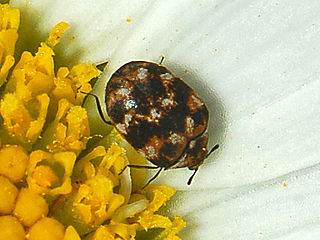
The varied carpet beetle is a 3 mm-long beetle belonging to the family Dermestidae, positioned in subgenus Nathrenus. They are a common species, often considered a pest of domestic houses and, particularly, natural history museums, where the larvae may damage natural fibers and can damage carpets, furniture, clothing, and insect collections. A. verbasci was also the first insect to be shown to have an annual behavioral rhythm and to date remains a classic example of circannual cycles in animals.

The Lānaʻi hookbill is an extinct species of Hawaiian honeycreeper. It was endemic to the island of Lānaʻi in Hawaiʻi, and was last seen in the southwestern part of the island. George C. Munro collected the only known specimen of this species in 1913, which is housed in the Bernice P. Bishop Museum in Honolulu, and saw the species only twice more, once in 1916 and for a final time in 1918. No other sightings have been reported. They inhabited montane dry forests dominated by ʻakoko and ōpuhe. The Lānaʻi hookbill was monotypic within the genus Dysmorodrepanis and had no known subspecies. Its closest relative is believed to be the ʻōʻū, and some early authors suggested that the Lānaʻi hookbill was merely a deformed ʻōʻū. The Lānaʻi hookbill was a plump, medium-sized bird with greenish olive upperparts and pale whitish yellow underparts. It also had a yellow or white superciliary line and a white chin and throat. The wings also had a distinctive and conspicuous white wing patch. The hookbill's distinguishing characteristic was its heavy, parrotlike bill, which had the mandibles hooking sharply towards each other, leaving a gap between them when the beak was closed.

Elaeocarpus munroi is a species of flowering plant in the Elaeocarpaceae family. It is endemic to the Western Ghats of southern India, in the states of Tamil Nadu, Maharashtra, and Karnataka. It grows in montane evergreen rain forest and shola forest from 600 to 2,000 metres elevation.
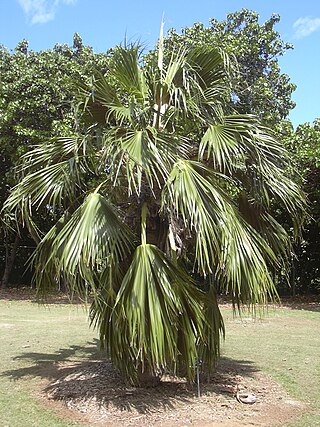
Pritchardia munroi, the Kamalo pritchardia, is a species of fan palm that is endemic to Hawaii in the United States. It is found in dry forests on the eastern (leeward) side of the island of Molokaʻi. The specific epithet, refers to James Monro, the manager of the Molokai Ranch at the time of its discovery (1920). Only two individuals exist in the wild, and both are at an elevation of 610 m (2,000 ft). It reaches a height of 4–5 m (13–16 ft) and a trunk diameter of 20 cm (7.9 in).
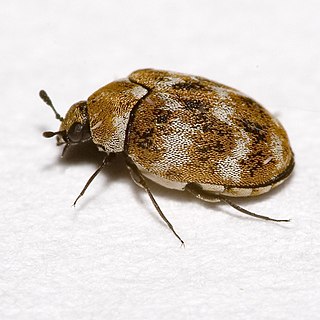
Anthrenus is a genus of beetles in the family Dermestidae, the skin beetles. One of several genera of carpet beetles, Anthrenus was historically placed in a subfamily Anthreninae, though presently included in the Megatominae. The genus Neoanthrenus is closely related.
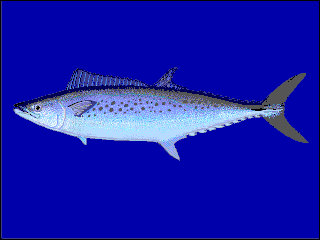
The Australian spotted mackerel is a species of fish in the family Scombridae. Common fork length ranges between 50 and 80 cm. Specimens have been recorded at up to 104 cm in length, and weighing up to 10.2 kg. It is found in the western Pacific, along the northern coast of Australia, from the Abrolhos Islands region of Western Australia to Coffs Harbour and Kempsey in central New South Wales. It is also found in southern Papua New Guinea from Kerema to Port Moresby. It feeds largely on fishes, particularly anchovies and sardines, with smaller quantities of shrimps and squids. It is sometimes confused with Japanese Spanish mackerel, S. niphonius. Conservation status of the species has been evaluated as Near Threatened by the IUCN. This species was described in 1980 and was previously confused with the Japanese Spanish mackerel of the north western Pacific but S. munroi has a different visceral structure, more vertebrae and fewer gill rakers.

Megatominae is a subfamily of the beetle family Dermestidae. This subfamily contains several of the most well-known household and stored-product pest beetles, in the genera Anthrenus and Trogoderma.

Anthrenus pimpinellae is a species of beetle found natively in Europe, northern Africa, Asia and portions of the Oriental region; it has also been introduced to parts of North America.

Anthrenus museorum, commonly known as the museum beetle, is a species of beetle found in the Palearctic, the Near East and the Nearctic. In its larval form it damages all forms of dry skin and hair. The larva will also eat dry cheese, flour or cocoa occasionally. It is considered a pest, as it damages, among others, the skin of taxidermied animals, such as polar bears and big cats in museums.
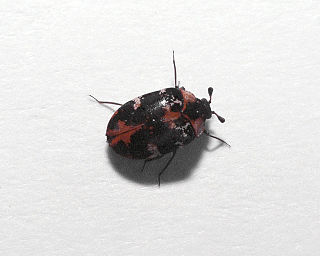
Anthrenus (Anthrenus) scrophulariae, also known as the common carpet beetle or buffalo carpet beetle, is a species of beetle originally found in Europe, the Middle East and the Nearctic, which has now spread to most of the world. Adult beetles feed on pollen and nectar, but the larvae feed on animal fibres and can be damaging pests to carpets, fabrics and museum specimens.

Anthrenus lepidus is a species of carpet beetle in the family Dermestidae. It is found in North America.

Anthrenus fuscus is a species of carpet beetle in the family Dermestidae. It is found in North America and Europe.

Apterocyclus munroi is a species of stag beetle in the family Lucanidae. It was found on the island of Kauai in the Hawaiian Islands in 1897.

Anthrenus festivus is a species of carpet beetle in the family Dermestidae. It is generally found in Western Europe: Austria, France, Germany, Portugal, Italy, Spain, Switzerland. Species also appears in Northern Africa, Israel and possibly in Cyprus.

Anthrenops is a subgenus of the genus Anthrenus of the subfamily Megatominae within the family of skin beetles. Subgenus is distinguished by antennae with 9 segments.

Anthrenus is a subgenus of the genus Anthrenus of the subfamily Megatominae within the family of skin beetles.

Anthrenus pimpinellae complex is a group of closely related species from subgenus Anthrenus. Most species that currently belong to the group were previously assigned as subspecies of Anthrenus pimpinellae.

Anthrenus olgae is a species of carpet beetle in the subgenus Florilinus of the genus Anthrenus, family Dermestidae. It is known from Europe in countries such as Austria, Bulgaria, Cyprus, Czech Republic, United Kingdom, Finland, Germany, Hungary, Latvia, Montenegro, Netherlands, Poland, Russia, Slovakia, Sweden and Ukraine. It has been introduced to Canada.




















